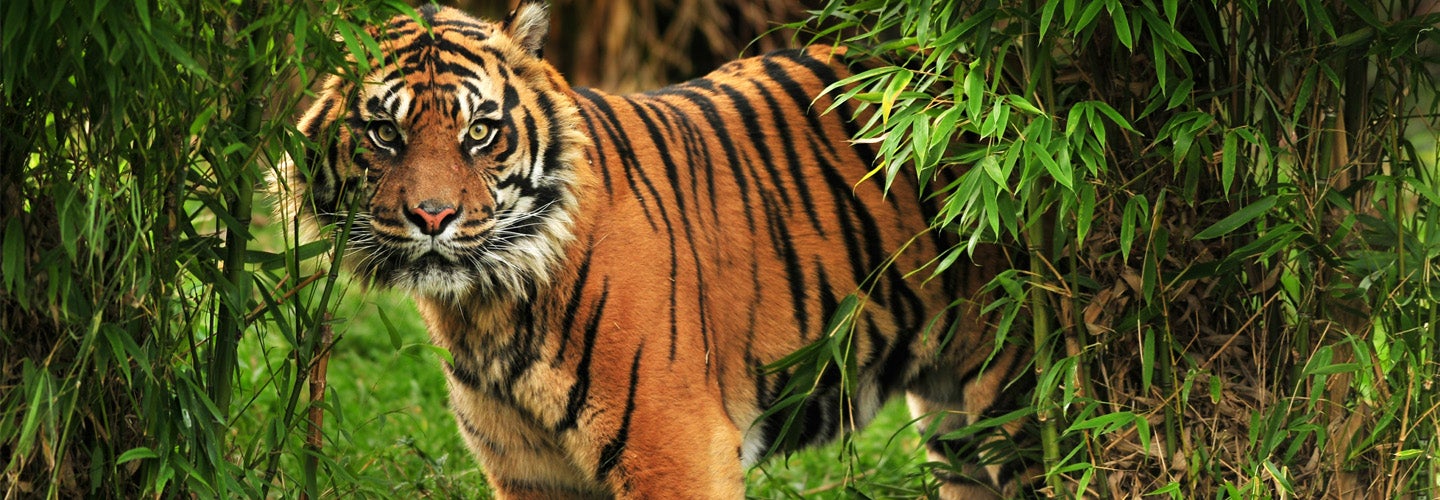 Scary looking male royal Bengal tiger staring towards the camera from inside the jungle
Scary looking male royal Bengal tiger staring towards the camera from inside the jungle
In 2014, when the World Bank Group joined a meeting hosted by then-Prince Charles to discuss illegal wildlife trade, an elephant was poached every 20 minutes. Ten years later, poaching is declining across much of Africa, a success won on the backs of the hard work of countries, communities, and civil society . So, what have we achieved in the last decade?
Since environmental crime is often a transnational enterprise, the responses needed to be, too. Ten years ago marked a major milestone in global cooperation for wildlife conservation when 46 countries signed the London Declaration on the Illegal Wildlife Trade. They pledged to strengthen laws against poaching and reduce demand for wildlife products through behavior change and laws that criminalized import or use of illegally traded species. Recognizing the risks of overexploitation, the declaration also called for the sustainable, legal, and traceable use of wildlife. This complemented regulations by the Convention on International Trade in Endangered Species of Wild Fauna and Flora (CITES), which set the stage for a coordinated response—from supply to demand—with strong partnerships across law enforcement agencies, the private sector, and communities impacted by the menace of illegal wildlife trade.
This authorizing environment spurred tangible policy and enforcement impacts in countries across the trafficking chain. Alongside these policies were better-resourced public institutions supported by civil society and community organizations. One way we see the benefits of this cooperation is in efforts under the Global Wildlife Program, a Global Environment Facility-financed $365 million program working in 38 countries to support governments in strengthening wildlife economies, eliminating wildlife crime, and building human-wildlife coexistence. Through this program, stronger anti-poaching measures were put in place in almost 100 critical sites for global biodiversity. We have already observed reduced poaching in 20 of these sites, from the desert-adapted elephants of Mali to Sumatran tigers and rhinoceros in Indonesia’s Leuser landscape. For example, improved enforcement capacity in Ethiopia has resulted in 90 percent of illegal wildlife trade cases presented in national courts ending in convictions with appropriate sentences. Behavior change initiatives in Thailand have led to a 30 percent reduction in consumer intention to purchase ivory and tiger amulets.
New and old technologies were also put into service to stop wildlife crime in its tracks. For instance, digital technologies in Vietnam help protected area managers better monitor, patrol, and report on poaching and other direct threats to biodiversity. In Republic of Congo, specialized sniffer dogs can now detect illegal wildlife products and in Gabon, the World Bank Group helped finance the first Wildlife Genetic Analysis Center in Central Africa to trace sources of ivory. Modernizing the ranger workforce— with adequate workforce protections, fit-for-purpose equipment, and supportive leadership—remains the most important predictor of success for catching criminals in the act and, better yet, deterring them from acting at all.
With this success, however, has also come new challenges. The resurgence of wildlife populations has had consequences for humans. Seventy-three percent of respondents in a survey by the Global Wildlife Program observed that human-wildlife conflict is increasing in their country and, in low-income countries, is threatening food security and oftentimes their lives. Ranchers in southern Panama, for example, have seen jaguar numbers rebound, only to find their own livestock at risk. In response, again old and new technologies are helping. They are being used to protect livestock by tracking jaguar migration patterns and to determine livestock grazing patterns. Installing fencing and alarms is also useful, as observed in India’s Himalayan region, where deterrent alarm systems led to a 50 to 75 percent reduction in agricultural losses from blue sheep. Building insurance schemes, which serve as safety nets to compensate for lost crops or lost livestock, may also be a last resort option, but an increasingly important one as we and wildlife share the same landscapes.
Ultimately, nothing will turn the tide against wildlife crime and offset the risks of more human-wildlife conflict like a thriving, legal wildlife economy . In Zambia, where 40 percent of land is under some kind of protection, 7.2 percent of jobs and 7 percent of people’s incomes are fueled by travel and tourism. Just two national parks alone provide over 35,000 jobs. When wildlife creates jobs and contributes to people’s incomes, it influences communities and the government to better manage and conserve it, so everyone is better off.


Join the Conversation